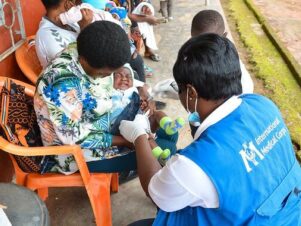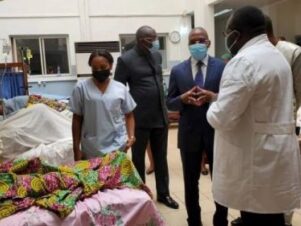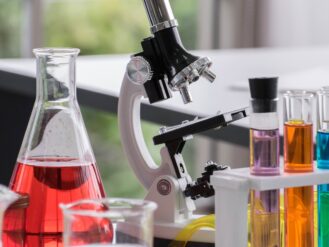The trachomatis bacteria that causes chlamydia (an STI) can be detected using a chlamydia test. With the chlamydia you can find out if you are infected with the chlamydia bacteria. In this article I will be talking about how the chlamydia diagnostic test is done at bigmanlab and the prescriptions recommend for chlamydia treatment.
At bigmanlab we take a sample of discharge from your penis or rectum or vagina or your urine and send it to a laboratory for testing. Usually our patients don’t need to wait for too long for results as we release them within the same day. While waiting for your results you should avoid sex.
Getting tested is the only way to know if you are infected with chlamydia. Whether or not you have chlamydia symptoms, you can get tested. At bigmanlab we often offer chlamydia test women below 25 years of age when they visit our center.
What is a chlamydia test?
The most common bacterial STI or (sexually transmitted infection) in Cameroon is detected by a chlamydia test. Looking for the chlamydia causing bacteria (Chlamydia trachomatis) is the objective of the chlamydia test. At bigmanlab we remove discharge from your throat, vagina, anus, or eye (based on the site of infection) or we collect your urine as a sample. Most of the time, we carry out this test in our labs. However, you may be able to test yourself with a home test kit which we also offer you.
Chlamydia test purpose
Determining if you have been infected with chlamydia is the purpose of this test. At bigmanlab we rely on screening tests to diagnose most infections as most people with chlamydia have no symptoms. Health conditions are diagnosed using screening tests before the symptoms appear. Sexually transmitted disease screening usually involves screening for many sexually transmitted diseases at the same time even though we usually can screen for just chlamydia.
Diagnostic tests are used to rule out or confirm chlamydia as the cause of the symptoms when symptoms associated with chlamydia occur. We will most likely test you for gonorrhea when you have chlamydia symptoms because chlamydia can cause symptoms similar to another common sexually transmitted disease called gonorrhea.
Who should get a chlamydia test?
At bigmanlab we recommends screening for chlamydia for:
Sexually active women 25 years of age or younger:
We recommended annual chlamydia screening in this group since the rate of infection rates are higher. Get tested if you have a new sexual partner even if you've been tested before.
Expectant women:
At your first prenatal checkup you should be tested for chlamydia. Get tested again later in your pregnancy if you are at high risk of infection, because your regular partner may be infected or through multiple sexual partners.
Men and women at high risk:
People who don't always use condoms and with multiple sexual partners, or homosexuals should consider regular chlamydia screening. Ongoing infection with other sexually transmitted infections constitute other indicators of high risk and also possible exposure to sexually transmitted diseases from an infected partner.
How does the chlamydia diagnostic test work?
To perform a chlamydia test, we collect a sample of fluid from the site of infection on your body. Bigmanlab uses two ways to collect test samples:

First capture the urine sample:
The first part of the urine stream is trapped in a sterile cup. We ask our patients to stop urinating two hours prior to the test in order to get an accurate test result.
Swab sample:
We use a special brush or swab to collect cells, often from your genital area (vagina or urethra). This can result to momentary discomfort. In some cases, we may swab your eyes, throat, cervix or rectum. According to special guidelines, we may give you a chance to swab by yourself.
NAAT () Test is the most commonly used type of chlamydia test for. Nucleic Acid Amplification recognizes the bacteria DNA that cause chlamydia. Provide a urine sample. Bigmanlab technicians examine samples for signs of chlamydia bacteria. Less commonly, we also us cell cultures to diagnose chlamydia.
We do this by taking a swab from your anus, vagina, or urethra to collect cell and fluid samples. The samples are then analyzed in the lab. There will be growth if bacteria is present as an indication of infection. Who mostly chose this type of chlamydia test when screening anal bacterial infections. Or to see how a chlamydia treatment is working, we use cell cultures.
What about home diagnosis for chlamydia?
Home tests for chlamydia are also available even though our technicians are responsible for doing the test at bigmanlab. Most home tests for chlamydia are self-collection test kits that allow you to collect a home urine or swab sample and mail to our laboratory. We may suggest a confirmatory chlamydia test using a laboratory method if a home test is positive.
Chlamydia result interpretation
- Negative: This means that at the time the sample was taken you do not have a chlamydia infection.
- Positive: This means you had chlamydia at the time the sample was collected.
You will need antibiotics if the test is positive to treat the infection. We also offer you with detailed instructions on how to take the prescribed medicines. Follow the instructions keenly and use all of the medicine to ensure the infection clears up totally.
For your sex partner to be tested and treated if they have chlamydia, we recommend you also tell them that you have tested positive for chlamydia. You will need to be retested for chlamydia to look for new infections some three months after stopping treatment. This is because recurrent infections are very common.
What about chlamydia treatment
Bigmanlab prescribes antibiotics for chlamydia trachomatis treatment. We may give you a single dose or ask you to take the medication several times a day or daily for 5 to 10 days. The infection clears up in a week or two in most cases. Sex should be avoided during this period.
Even if sex partners don't have any symptoms or signs, they also needs treatment. Otherwise, the chlamydia infection can be spread between sex partners. Having received chlamydia treatment or having chlamydia in the past does not prevent you from getting infected again.
Note from bigmanlab
Slowing the spread of this sexually transmitted infection can be achieved through chlamydia testing. If you are at increased risk of this STI then it is very important to get regular chlamydia screening. If left untreated, chlamydia can be passed on to your partner and can cause health problems.
Avoid sexual intercourse while waiting for results and also during treatment. In fact we advise you to wait until tells you it is safe to have intercourse again. To avoid STDs, practice safe sex and use condoms.







